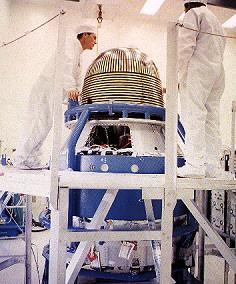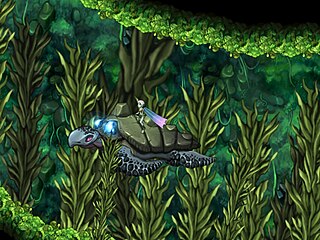Exovivaria - vivaria in outer space.
Origins of the term
"Exovivarium" is a Project Persephone neologism.
Introduction

We can't all go.
Life in space is an exciting prospect. Project Persephone aims to bring it down to Earth: to see if exovivaria - ecosystems in orbit, collectively governed but also hosting private property and commerce - can become an economical pastime for those of us who can't go. Teams on Earth would tend these ecosystems through video links and teleoperation, using the Internet to update each other on "the state of our worlds." Some members (mostly in the developing world) might be paid for their efforts. Others (mostly in the developed world) would pay to take part. Much of the "game value," whether it derived from earnings or just sheer fun, would be in feeling part of a team and in competing with other teams. However, the problem of keeping an ecosystem alive would also make this a Serious Game, one requiring some cooperation from all. You might think of it as a microcosmic Spaceship Earth.
The exovivarium is a compelling vision for a few, but still a blurry one for most. To be truly successful, designers of exovivaria must strive to meet the criteria of "a world worth talking about". How to get there from here? (Assuming it's even possible?) Technology demonstration projects in (near-) space, virtual exovivaria, and ground-based prototypes should all help Project staff, paying members and volunteers decide which exovivarium design features lend themselves to sustainable growth in demand, long before any launch of the first real exovivarium. The problem must be approached from several different angles at once: technological, social and economic.
If exovivaria succeed even modestly, they could help reduce the costs of (human) life support in space. If they become very popular, they might help reduce the costs of space launch by increasing the demand for space launch, which would improve the economies of scale of conventional (rocket) launch operations. If exovivaria experience overwhelming success, they would justify serious investment in speculative launch technologies that now languish unfunded, such projectile space launch. But even if exovivaria turn out not to be technologically or socially viable, we'll all learn useful lessons.
History

NASA's Biosatellite 3
Serious discussion of sending other living things to space for biological studies dates back as far as 1946.1 Sending other living creatures into space began even before manned spaceflight. The purpose was to study the effects of spaceflight on living things, and to experiment with systems for keeping them alive and healthy. The main focus of the earliest experiments was to get some idea of how human beings might cope with microgravity?. Even after human spaceflight began, however, studies on non-human life in space continued, with unmanned satellite launches. These included the Bion series of the USSR, with NASA cooperation, begun in 1966 and continuing until 1996, and NASA's own Biosatellite series in the mid-to-late 60s.
A more recent biosatellite effort was the Mars Gravity Biosatellite. The aim was to learn more about the effects of Mars-level gravity (38% that of Earth's) on small mammals, the better to understand how it might affect larger mammals like us. This project, which grew to include many student activities, was canceled in 2009. It was probably rendered obsolete by JAXA's Kibo (ki-BOH - "hope") module for ISS.

JAXA's Kibo biology lab, finally in place.
Kibo's Japanese Experiment Module (JEM) hosts a number of elements that prefigure Project Persephone needs, including
- a centrifuge module (CAM) that can produce between 0.1 and 2 Earth gravities;
- the Cell Biology Experiment Facility (CBEF);
- the Aquatic Habitat (AQH), a small research aquarium.
Kibo will see a number of low-gravity/microgravity experiments on plants and silkworms in its Cell Biology Experiment Facility in its first phase of utilization. In the second phase, there will be yet more plant experiments, and the first experiments on fish using the AQH.
At least one exovivarium featuring some degree of public access via video transmission has been proposed, though not launched: the Experiment Biosfera contract activity at Energia?.
Categories of interim goals
Exovivaria can only come together by inching from one interim goal to the next. Exovivaria will be complex, and will cost a lot to launch. It would be extremely expensive and failure-prone to evaluate exovivarium designs by simply launching various complete designs to see how well they work. The design problems must be approached incrementally, over periods of years, and from several different directions at once, well in advance of orbiting a full system.
Among the concurrent approaches to be taken:

DRAGONSat, a student project
Real (or near-) space experiments. The Project might try for early launch of small experimental systems, possibly in Cubesat configurations to begin with, or even smaller, in the case of biomagnetorquing experiments. These would not be expected to have any "game value" while on orbit, although competition might still be an element, insofar as teams compete to come up with the most fruitful experiments.
Stratosphere platforms will provide a relatively cheap way to test technology and concepts, especially those involving ground communications, and deployment and telebotic operations in a (near-) vacuum. Telebotic operations in microgravity might be tested in drop tower experiments, then move to suborbital flights? when longer uninterrupted periods of microgravity are required.

Aquaria videogame screenshot
Virtual exovivaria. An important (and more easily realized) goal is to simulate a wide variety of user experiences, to the extent possible, in a kind of MMORPG?. The computing power required is only going to become cheaper. Much could be learned about what might go wrong socially in such systems.
Also, insofar as virtual exovivaria are physically accurate simulations, they should help expose technological pitfalls before they became expensive real-world failures.

Terrarium denizens
Terrestrial prototypes. These can't simulate artificial low-gravity conditions, but they might otherwise closely resemble an orbiting exovivarium. The need might be great. Even the most detailed CGI rendering of the interiors of virtual exovivaria will probably fall short of perfect realism. But even if they didn't, they still wouldn't be "psychologically real": users would know that it was "all a game," that no real harm could be done (except perhaps to feelings, and perhaps to finances if some people are paying for privileges). In a real vivarium, things can break and creatures can die.2

Built with long tweezers
Solo telerobotic pastimes. Many exovivarium users might enjoy telebotic interaction only with their "pets," gardens and microfarms, and other things they own in the exovivarium; the only social dimension for such users would be in simply trading to get what's needed to do those things. One purpose of private property is "freedom from association;" it allows people accomplish things on their own. Arts and crafts, hobbies fed with biomaterials reaped within an exovivarium, from its "livestock" and its microfarms, might become delightful individual pastimes, even if the results only decorated the interior, never to be delivered to anyone on Earth. Even some purely functional exovivarium maintenance tasks might be compelling hobbies for some. Designing specialized terrestrial-prototype exovivaria for personal use should help in determining what kinds of enjoyment can be gotten individually, within systems that are larger in scale and more social in operation.

Wikipedia volunteers
Governance experiments. Orbit is expensive. For exovivaria to be economical, the designs must optimize the number of users that can be attracted and retained per orbited unit of payload. As much as anything else, this makes exovivarium design a hard problem. The more that people are forced to share a scarce resource, the more likely it is that they will either fight over it unproductively or simply move on, in search of more satisfying experiences. In general, the goal should be to make the experience of ecosystem management as recreational as possible for users in the developed world, and as much a source of gainful employment as possible for users from poorer places, while affording opportunities for other fruitful exchanges between the two user bases. It's inevitable that these design constraints will give rise to some form of government, to resolve the resulting conflicts. Experiments in governance need not be tied closely to exovivarium physical design, though they should eventually converge on it.
To be truly successful, exovivaria must meet the criteria of "a world worth talking about". Among the desiderata: Change, Engagement, Purpose, Connection -- all continously renewing themselves.
Longer-term results

A meal on ISS
Exovivarium development could help reduce the costs of extraterrestrial habitats for human beings. Insofar as the greater expense of human spaceflight owes to its stricter safety requirements, exovivaria - requiring only unmanned launch - could offer significant economies per pound of launched biomass and human life-support materials. In the case of projectile space launch, the launches need not even be survivable human beings, never mind issues of reliability. To meet basic human needs on orbit, edible plants and dead animals might be frozen instead of allowed to decay naturally; the oxygen that the dead animals would otherwise recycle might instead be absorbed chemically and stored. Exovivaria could also be a market for exports from manned orbital habitats: the surplus waste products of human visitors (sewage, CO2 exhalation, solids filtered from wash water) could be sent exovivaria, to replace what was lost by exports to those habitats.
References
1 Preliminary Design of an Experimental Worldcircling Spaceship, Ch. 2: L.N. Ridenour, "Significance of a Satellite Vehicle". Douglas Aircraft Co., May 2, 1946. "Biologists [...] would want to study life in the acceleration-free environment of the satellite. This is an important pre-requisite for space travel by man, and it may also lead to important new observations in lower forms of life." (p.14) ⇑
2 Experience so far suggests that such concerns can be evoked even with telebotic tending of a single plant, by school children in developing nations, using only small-screen mobile devices. See, e.g., "ROSE: Remotely Operated Science Experiment", Paul Kim, Aaron Sharp, Kevin Bing-Yung Wong, Arafeh Karimi, Kamakshi Duvvuru; Stanford University, Feb 2011. ⇑
Further reading
- Vivaria on Wikipedia
- Orbiting Frog Otolith on Wikipedia
- "Animals in space" on Wikipedia
- Fundamentals of Space Biology: Research on Cells, Animals, and Plants in Space, Gilles Clément, Springer, 2006/09/01, ISBN 1441922016
This page may have a more recent version on pmwiki.org: PmWiki:Exovivaria, and a talk page: PmWiki:Exovivaria-Talk.